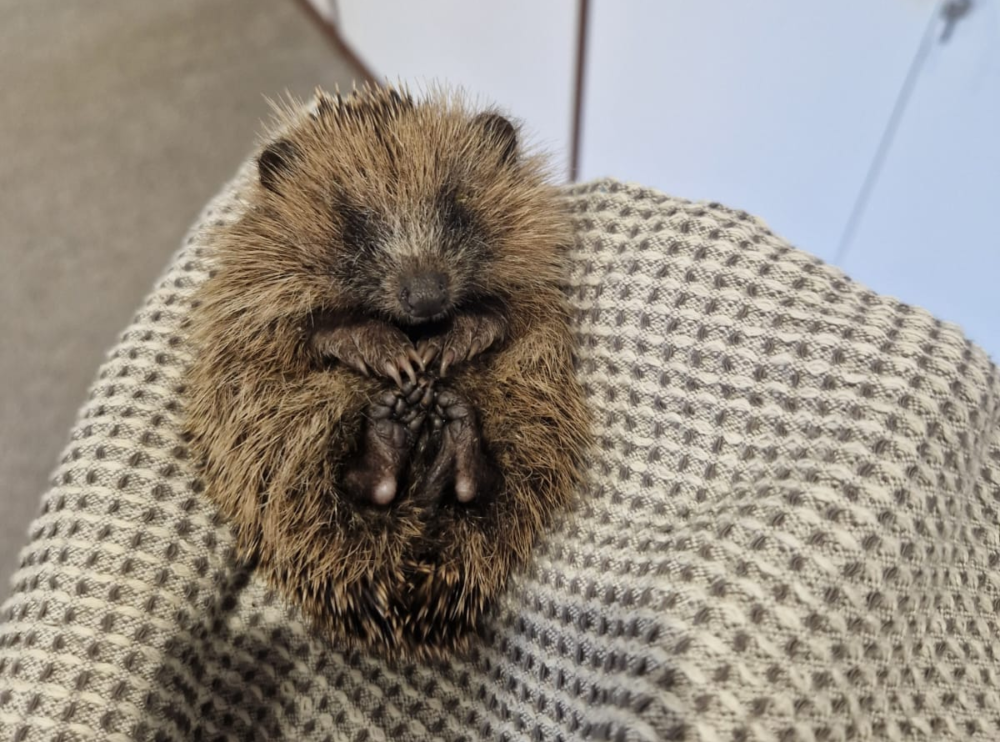Local housebuilder and Glamorgan Hedgehog Rescue help protect garden wildlife this Bonfire Night

Cute baby Hedgehog rescued this week in the showhome gardens
Hedgehogs are a welcome sight in anyone’s garden, but their numbers are in steep decline — having gone from around 30 million to just one million since the 1950s across Wales, Scotland and England.
At this time of year, hedgehogs see bonfires as the ideal place to shelter from predators as they start thinking about hibernation. After all, the piles are usually made up of all-natural materials, with plenty of nooks and crannies to hide in.
That is why housebuilder, Barratt Developments South Wales, has partnered with Glamorgan Hedgehog Rescue — to help homeowners ensure their gardens are a safe space where creatures, including the hedgehog, can thrive this Bonfire Night and beyond.
Glamorgan Hedgehog Rescue is a small local charity dedicated to the treatment and rehabilitation of sick and injured hedgehogs. To support this important work, the housebuilder has donated £500 to the charity.
Here are Glamorgan Hedgehog Rescue’s 5 ‘top tips’ to help you ensure your bonfire is as wildlife-safe as possible:
1. Avoid building your bonfire in advance
Although it may be easier to build your bonfire in the lead-up to Bonfire Night, it is always best to build the pile on the day you plan to light it. As we approach hibernation season, hedgehogs and other garden wildlife will be drawn to a big pile of logs and leaves as the perfect winter nest.
2. Move your bonfire before lighting it
If you do need to build your bonfire in advance of lighting it, try to move it to open ground on the day of lighting. It is important that the ground is open and clear, as leaves could be hiding hedgehogs from plain sight. Moving the bonfire will allow the hedgehogs to escape the pile in plenty of time.
3. Place a barrier around the edge of your bonfire
A barrier around the base of the bonfire will help prevent hedgehogs and other animals from getting in. Placing chicken wire — about 1m or higher with small holes — around the base of your bonfire will make it much harder for hedgehogs to get in.
4. Check your bonfire for hedgehogs before lighting it
Even if you took the previous precautions, it is always best to manually check your bonfire for hedgehogs and other animals before lighting. Use a long object, such as a broom handle, to gently poke your bonfire and move around the ground leaves. If you hear a hissing sound, then you have probably found an angry hedgehog!
5. Light your bonfire from one corner
Now you are ready to light your bonfire, be sure to only light it from one edge, rather than the centre. This allows any hedgehogs or other wildlife that may have gone unseen during your bonfire checks to escape before it reaches all areas of the pile.
Sue Verran, volunteer at Glamorgan Hedgehog Rescue, said: “We are grateful to Barratt South Wales for their donation to support our work. Our team is made up entirely of volunteers, so every penny will go towards the treatment and rehabilitation of the hedgehogs in our care.
Lewis Allwood, Charity Champion at Barratt Developments South Wales and lover of the great outdoors, added: “When building new homes in South Wales, protecting and enhancing natural habitats is of utmost importance to us.
“We know just how critical this pre-hibernation period is for our local wildlife, and we therefore encourage homeowners to play their part by keeping their gardens a bit messier over winter — providing much-needed cover for hedgehogs when they occasionally wake from hibernation.
“In fact, a member of our sales team rescued an abandoned baby hedgehog found in one of our show home gardens, this week!”
To find out more about Glamorgan Hedgehog Rescue and to make a donation, visit: www.glamorganhedgehogrescue.com
To find out more about new homes in the Vale of Glamorgan, visit: www.barratthomes.co.uk/new-homes/wales/south-wales/vale-of-glamorgan/